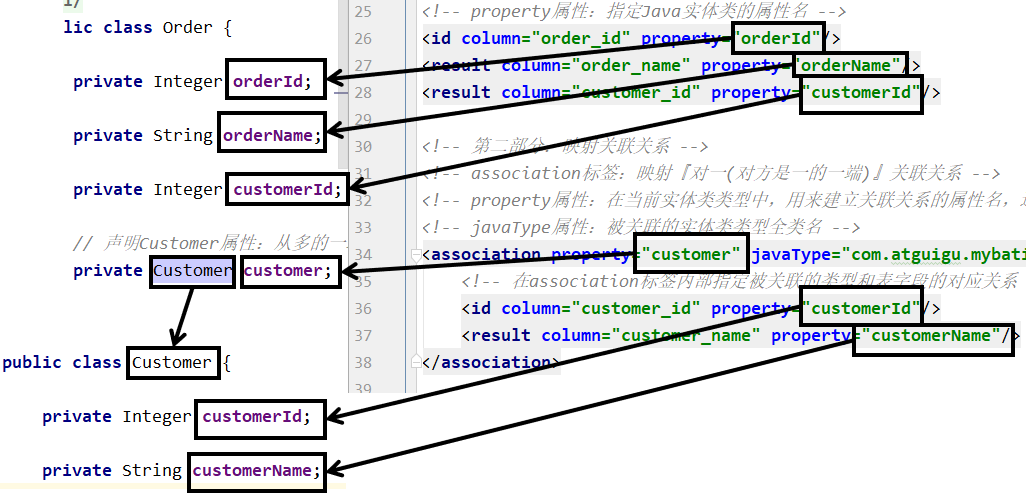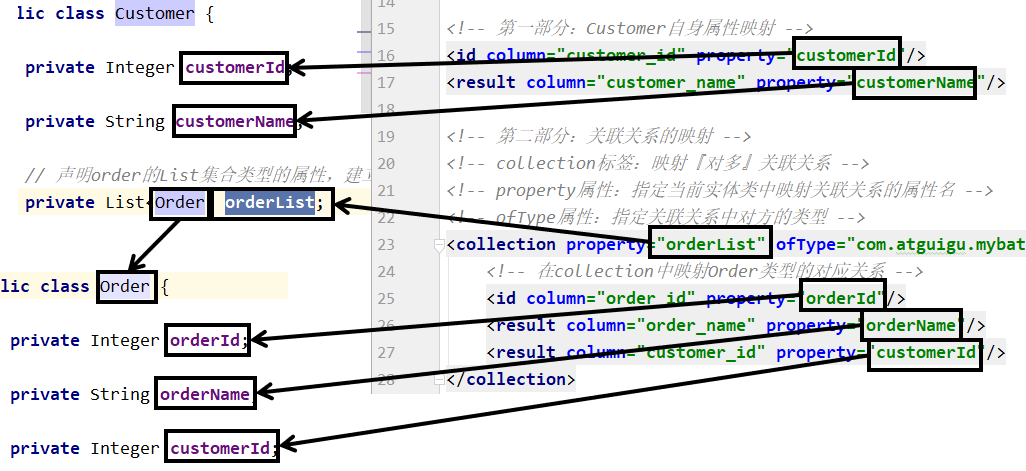1.Mybatis快速入门
官方文档:https://mybatis.org/mybatis-3/zh_CN/index.html
1.1依赖导入
pom.xml
<dependencies>
<!-- mybatis依赖 -->
<dependency>
<groupId>org.mybatis</groupId>
<artifactId>mybatis</artifactId>
<version>3.5.11</version>
</dependency>
<!-- MySQL驱动 mybatis底层依赖jdbc驱动实现,本次不需要导入连接池,mybatis自带! -->
<dependency>
<groupId>mysql</groupId>
<artifactId>mysql-connector-java</artifactId>
<version>8.0.25</version>
</dependency>
<!--junit5测试-->
<dependency>
<groupId>org.junit.jupiter</groupId>
<artifactId>junit-jupiter-api</artifactId>
<version>5.3.1</version>
</dependency>
</dependencies>1.2定义mapper接口和接口mapper.xml文件
定义mapper.xml 位置: resources/mappers/EmployeeMapper.xml
<?xml version="1.0" encoding="UTF-8" ?>
<!DOCTYPE mapper
PUBLIC "-//mybatis.org//DTD Mapper 3.0//EN"
"https://mybatis.org/dtd/mybatis-3-mapper.dtd">
<!-- namespace等于mapper接口类的全限定名,这样实现对应 -->
<mapper namespace="com.atguigu.mapper.EmployeeMapper">
<!-- 查询使用 select标签
id = 方法名
resultType = 返回值类型
标签内编写SQL语句
-->
<select id="selectEmployee" resultType="com.atguigu.pojo.Employee">
<!-- #{empId}代表动态传入的参数,并且进行赋值!后面详细讲解 -->
select emp_id empId,emp_name empName, emp_salary empSalary from
t_emp where emp_id = #{empId}
</select>
</mapper>- 方法名和SQL的id一致
- 方法返回值和resultType一致
- 方法的参数和SQL的参数一致
- 接口的全类名和映射配置文件的名称空间一致
mapper接口:
package com.atguigu.mapper;
import com.atguigu.pojo.Employee;
/**
* t_emp表对应数据库SQL语句映射接口!
* 接口只规定方法,参数和返回值!
* mapper.xml中编写具体SQL语句!
*/
public interface EmployeeMapper {
/**
* 根据员工id查询员工数据方法
* @param empId 员工id
* @return 员工实体对象
*/
Employee selectEmployee(Integer empId);
}1.3定义配置文件mybatis-config.xml
<?xml version="1.0" encoding="UTF-8" ?>
<!DOCTYPE configuration
PUBLIC "-//mybatis.org//DTD Config 3.0//EN"
"http://mybatis.org/dtd/mybatis-3-config.dtd">
<configuration>
<!-- environments表示配置Mybatis的开发环境,可以配置多个环境,在众多具体环境中,使用default属性指定实际运行时使用的环境。default属性的取值是environment标签的id属性的值。 -->
<environments default="development">
<!-- environment表示配置Mybatis的一个具体的环境 -->
<environment id="development">
<!-- Mybatis的内置的事务管理器,JDBC会默认开启事务 -->
<transactionManager type="JDBC"/>
<!-- 配置数据源,使用连接池 -->
<dataSource type="POOLED">
<!-- 建立数据库连接的具体信息 -->
<property name="driver" value="com.mysql.cj.jdbc.Driver"/>
<property name="url" value="jdbc:mysql://localhost:3306/mybatis-example"/>
<property name="username" value="root"/>
<property name="password" value="root"/>
</dataSource>
</environment>
</environments>
<mappers>
<!-- Mapper注册:指定Mybatis映射文件的具体位置 -->
<!-- mapper标签:配置一个具体的Mapper映射文件 -->
<!-- resource属性:指定Mapper映射文件的实际存储位置,这里需要使用一个以类路径根目录为基准的相对路径 -->
<!-- 对Maven工程的目录结构来说,resources目录下的内容会直接放入类路径,所以这里我们可以以resources目录为基准 -->
<mapper resource="mappers/EmployeeMapper.xml"/>
</mappers>
</configuration>1.4运行和测试
/**
* projectName: com.atguigu.test
*
* description: 测试类
*/
public class MyBatisTest {
@Test
public void testSelectEmployee() throws IOException {
// 1.创建SqlSessionFactory对象
// ①声明Mybatis全局配置文件的路径
String mybatisConfigFilePath = "mybatis-config.xml";
// ②以输入流的形式加载Mybatis配置文件
InputStream inputStream = Resources.getResourceAsStream(mybatisConfigFilePath);
// ③基于读取Mybatis配置文件的输入流创建SqlSessionFactory对象
SqlSessionFactory sessionFactory = new SqlSessionFactoryBuilder().build(inputStream);
// 2.使用SqlSessionFactory对象开启一个会话
SqlSession session = sessionFactory.openSession();
// 3.根据EmployeeMapper接口的Class对象获取Mapper接口类型的对象(动态代理技术)
EmployeeMapper employeeMapper = session.getMapper(EmployeeMapper.class);
// 4. 调用代理类方法既可以触发对应的SQL语句
Employee employee = employeeMapper.selectEmployee(1);
System.out.println("employee = " + employee);
// 4.关闭SqlSession
session.commit(); //提交事务 [DQL不需要,其他需要]
session.close(); //关闭会话
}
}2.MyBatis基本使用
2.1参数传递
{}形式传参:Mybatis会将SQL语句中的#{}转换为问号占位符。
${}形式传参,底层Mybatis做的是字符串拼接操作。
推荐使用#{},防止注入攻击的问题
动态值使用#{key},动态的列名、容器名、关键字使用${key}
注解方式传入参数:
//注解方式传入参数!!
@Select("select * from user where ${column} = #{value}")
User findByColumn(@Param("column") String column,
@Param("value") String value);2.2数据输入
1.单个简单参数
Employee selectEmployee(Integer empId);sql语句
<select id="selectEmployee" resultType="com.atguigu.mybatis.entity.Employee">
select emp_id empId,emp_name empName,emp_salary empSalary from t_emp where emp_id=#{empId}
</select>2.实体类型参数
int insertEmployee(Employee employee);sql语句
<insert id="insertEmployee">
insert into t_emp(emp_name,emp_salary) values(#{empName},#{empSalary})
</insert>Mybatis会根据#{}中传入的数据,加工成getXxx()方法,通过反射在实体类对象中调用这个方法,从而获取到对应的数据。填充到#{}解析后的问号占位符这个位置。
3.多个简单类型数据
零散的多个简单类型参数,如果没有特殊处理,那么Mybatis无法识别自定义名称
//1.通过注解指定
//2.xml中按次序填写arg0、arg1....
int updateEmployee(@Param("empId") Integer empId,@Param("empSalary") Double empSalary);sql:
<update id="updateEmployee">
update t_emp set emp_salary=#{empSalary} where emp_id=#{empId}
</update>4.Map类型参数
int updateEmployeeByMap(Map<String, Object> paramMap);sql:填入map中的key值
<update id="updateEmployeeByMap">
update t_emp set emp_salary=#{empSalaryKey} where emp_id=#{empIdKey}
</update>2.2数据输出
增删改操作返回的受影响行数:直接使用 int 或 long 类型接收即可
2.2.1单个简单参数
Mapper接口中的抽象方法
int selectEmpCount();Sql语句,通过resultType指定返回类型
<select id="selectEmpCount" resultType="int">
select count(*) from t_emp
</select>2.2.2实体类对象
1.类别名设置
<typeAliases>
<typeAlias alias="Author" type="domain.blog.Author"/>
<typeAlias alias="Blog" type="domain.blog.Blog"/>
</typeAliases>或者直接指定包名,类的别名为bean名称首字母小写
<typeAliases> <package name="domain.blog"/> </typeAliases>2.开启属性名映射
<!-- 在全局范围内对Mybatis进行配置 -->
<settings>
<!-- 具体配置 -->
<!-- 从org.apache.ibatis.session.Configuration类中可以查看能使用的配置项 -->
<!-- 将mapUnderscoreToCamelCase属性配置为true,表示开启自动映射驼峰式命名规则 -->
<!-- 规则要求数据库表字段命名方式:单词_单词 -->
<!-- 规则要求Java实体类属性名命名方式:首字母小写的驼峰式命名 -->
<setting name="mapUnderscoreToCamelCase" value="true"/>
</settings><!-- 编写具体的SQL语句,使用id属性唯一的标记一条SQL语句 -->
<!-- resultType属性:指定封装查询结果的Java实体类的全类名 -->
<select id="selectEmployee" resultType="com.atguigu.mybatis.entity.Employee">
<!-- Mybatis负责把SQL语句中的#{}部分替换成“?”占位符 -->
<!-- 给每一个字段设置一个别名,让别名和Java实体类中属性名一致 -->
select emp_id empId,emp_name empName,emp_salary empSalary from t_emp where emp_id=#{maomi}
</select>2.2.3返回Map类型
适用于SQL查询返回的各个字段综合起来并不和任何一个现有的实体类对应,没法封装到实体类对象中。能够封装成实体类类型的,就不使用Map类型。
Mapper接口的抽象方法
Map<String,Object> selectEmpNameAndMaxSalary();sql语句
<!-- Map<String,Object> selectEmpNameAndMaxSalary(); -->
<!-- 返回工资最高的员工的姓名和他的工资 -->
<select id="selectEmpNameAndMaxSalary" resultType="map">
SELECT
emp_name 员工姓名,
emp_salary 员工工资,
(SELECT AVG(emp_salary) FROM t_emp) 部门平均工资
FROM t_emp WHERE emp_salary=(
SELECT MAX(emp_salary) FROM t_emp
)
</select>2.2.4返回List类型
List<Employee> selectAll();<!-- List<Employee> selectAll(); -->
<select id="selectAll" resultType="com.atguigu.mybatis.entity.Employee">
select emp_id empId,emp_name empName,emp_salary empSalary
from t_emp
</select>2.2.5返回主键值
自增长类型
int insertEmployee(Employee employee);<!-- int insertEmployee(Employee employee); -->
<!-- useGeneratedKeys属性字面意思就是“使用生成的主键” -->
<!-- keyProperty属性可以指定主键在实体类对象中对应的属性名,Mybatis会将拿到的主键值存入这个属性 -->
<!-- keyColumn属性为数据库表对应的属性 -->
<insert id="insertEmployee" useGeneratedKeys="true" keyColumn="emp_id" keyProperty="empId">
insert into t_emp(emp_name,emp_salary)
values(#{empName},#{empSalary})
</insert>非自增长
selectKey 元素将会首先运行,id 会被设置,然后插入语句会被调用
<insert id="insertUser" parameterType="User">
<!-- 使用 selectKey 来查询 UUID 并设置到 id 字段中 ,order属性表示在插入语句之前还是之后执行-->
<selectKey keyProperty="id" resultType="java.lang.String"
order="BEFORE">
SELECT UUID() as id
</selectKey>
INSERT INTO user (id, username, password)
VALUES (
#{id},
#{username},
#{password}
)
</insert>2.3实体属性名称和数据库名称映射
方式1:在sql给每一个字段设置一个别名
<!-- 编写具体的SQL语句,使用id属性唯一的标记一条SQL语句 -->
<!-- resultType属性:指定封装查询结果的Java实体类的全类名 -->
<select id="selectEmployee" resultType="com.atguigu.mybatis.entity.Employee">
<!-- Mybatis负责把SQL语句中的#{}部分替换成“?”占位符 -->
<!-- 给每一个字段设置一个别名,让别名和Java实体类中属性名一致 -->
select emp_id empId,emp_name empName,emp_salary empSalary from t_emp where emp_id=#{maomi}
</select>方式2:全局配置自动识别驼峰式命名规则
方式3:使用resultMap(resultMap和resultType二选一)
<!-- 专门声明一个resultMap设定column到property之间的对应关系 -->
<resultMap id="selectEmployeeByRMResultMap" type="com.atguigu.mybatis.entity.Employee">
<!-- 使用id标签设置主键列和主键属性之间的对应关系 -->
<!-- column属性用于指定字段名;property属性用于指定Java实体类属性名 -->
<id column="emp_id" property="empId"/>
<!-- 使用result标签设置普通字段和Java实体类属性之间的关系 -->
<result column="emp_name" property="empName"/>
<result column="emp_salary" property="empSalary"/>
</resultMap>
<!-- Employee selectEmployeeByRM(Integer empId); -->
<select id="selectEmployeeByRM" resultMap="selectEmployeeByRMResultMap">
select emp_id,emp_name,emp_salary from t_emp where emp_id=#{empId}
</select>2.4总结
select 元素允许你配置很多属性来配置每条语句的行为细节:
| 属性 | 描述 |
|---|---|
id | 在命名空间中唯一的标识符,可以被用来引用这条语句。 |
resultType | 期望从这条语句中返回结果的类全限定名或别名。 注意,如果返回的是集合,那应该设置为集合包含的类型,而不是集合本身的类型。 resultType 和 resultMap 之间只能同时使用一个。 |
resultMap | 对外部 resultMap 的命名引用。结果映射是 MyBatis 最强大的特性,如果你对其理解透彻,许多复杂的映射问题都能迎刃而解。 resultType 和 resultMap 之间只能同时使用一个。 |
timeout | 这个设置是在抛出异常之前,驱动程序等待数据库返回请求结果的秒数。默认值为未设置(unset)(依赖数据库驱动)。 |
statementType | 可选 STATEMENT,PREPARED 或 CALLABLE。这会让 MyBatis 分别使用 Statement,PreparedStatement 或 CallableStatement,默认值:PREPARED。 |
insert, update 和 delete标签:
数据变更语句 insert,update 和 delete 的实现非常接近:
| 属性 | 描述 |
|---|---|
id | 在命名空间中唯一的标识符,可以被用来引用这条语句。 |
timeout | 这个设置是在抛出异常之前,驱动程序等待数据库返回请求结果的秒数。默认值为未设置(unset)(依赖数据库驱动)。 |
statementType | 可选 STATEMENT,PREPARED 或 CALLABLE。这会让 MyBatis 分别使用 Statement,PreparedStatement 或 CallableStatement,默认值:PREPARED。 |
useGeneratedKeys | (仅适用于 insert 和 update)这会令 MyBatis 使用 JDBC 的 getGeneratedKeys 方法来取出由数据库内部生成的主键(比如:像 MySQL 和 SQL Server 这样的关系型数据库管理系统的自动递增字段),默认值:false。 |
keyProperty | (仅适用于 insert 和 update)指定能够唯一识别对象的属性,MyBatis 会使用 getGeneratedKeys 的返回值或 insert 语句的 selectKey 子元素设置它的值,默认值:未设置(unset)。如果生成列不止一个,可以用逗号分隔多个属性名称。 |
keyColumn | (仅适用于 insert 和 update)设置生成键值在表中的列名,在某些数据库(像 PostgreSQL)中,当主键列不是表中的第一列的时候,是必须设置的。如果生成列不止一个,可以用逗号分隔多个属性名称。 |
3.多表映射
3.1对一映射
根据ID查询订单,以及订单关联的用户的信息
OrderMapper.xml配置文件
<!-- 创建resultMap实现“对一”关联关系映射 -->
<!-- id属性:通常设置为这个resultMap所服务的那条SQL语句的id加上“ResultMap” -->
<!-- type属性:要设置为这个resultMap所服务的那条SQL语句最终要返回的类型 -->
<resultMap id="selectOrderWithCustomerResultMap" type="order">
<!-- 先设置Order自身属性和字段的对应关系 -->
<id column="order_id" property="orderId"/>
<result column="order_name" property="orderName"/>
<!-- 使用association标签配置“对一”关联关系 -->
<!-- property属性:在Order类中对一的一端进行引用时使用的属性名 -->
<!-- javaType属性:一的一端类的全类名 -->
<association property="customer" javaType="customer">
<!-- 配置Customer类的属性和字段名之间的对应关系 -->
<id column="customer_id" property="customerId"/>
<result column="customer_name" property="customerName"/>
</association>
</resultMap>
<!-- Order selectOrderWithCustomer(Integer orderId); -->
<select id="selectOrderWithCustomer" resultMap="selectOrderWithCustomerResultMap">
SELECT order_id,order_name,c.customer_id,customer_name
FROM t_order o
LEFT JOIN t_customer c
ON o.customer_id=c.customer_id
WHERE o.order_id=#{orderId}
</select>对应关系:
3.2对多映射
查询客户和客户关联的订单信息
CustomerMapper.xml文件
<!-- 配置resultMap实现从Customer到OrderList的“对多”关联关系 -->
<resultMap id="selectCustomerWithOrderListResultMap"
type="customer">
<!-- 映射Customer本身的属性 -->
<id column="customer_id" property="customerId"/>
<result column="customer_name" property="customerName"/>
<!-- collection标签:映射“对多”的关联关系 -->
<!-- property属性:在Customer类中,关联“多”的一端的属性名 -->
<!-- ofType属性:集合属性中元素的类型 -->
<collection property="orderList" ofType="order">
<!-- 映射Order的属性 -->
<id column="order_id" property="orderId"/>
<result column="order_name" property="orderName"/>
</collection>
</resultMap>
<!-- Customer selectCustomerWithOrderList(Integer customerId); -->
<select id="selectCustomerWithOrderList" resultMap="selectCustomerWithOrderListResultMap">
SELECT c.customer_id,c.customer_name,o.order_id,o.order_name
FROM t_customer c
LEFT JOIN t_order o
ON c.customer_id=o.customer_id
WHERE c.customer_id=#{customerId}
</select>对应关系:
3.3总结
| 关联关系 | 配置项关键词 | 所在配置文件和具体位置 |
|---|---|---|
| 对一 | association标签/javaType属性/property属性 | Mapper配置文件中的resultMap标签内 |
| 对多 | collection标签/ofType属性/property属性 | Mapper配置文件中的resultMap标签内 |
4.动态语句
4.1if和where标签
<!-- List<Employee> selectEmployeeByCondition(Employee employee); -->
<select id="selectEmployeeByCondition" resultType="employee">
select emp_id,emp_name,emp_salary from t_emp
<!-- where标签会自动去掉“标签体内前面多余的and/or”,并自动判断是否加上where -->
<where>
<!-- 使用if标签,让我们可以有选择的加入SQL语句的片段。这个SQL语句片段是否要加入整个SQL语句,就看if标签判断的结果是否为true -->
<!-- 在if标签的test属性中,可以访问实体类的属性,不可以访问数据库表的字段 -->
<if test="empName != null">
<!-- 在if标签内部,需要访问接口的参数时还是正常写#{} -->
or emp_name=#{empName}
</if>
<if test="empSalary > 2000">
or emp_salary>#{empSalary}
</if>
<!--
第一种情况:所有条件都满足 WHERE emp_name=? or emp_salary>?
第二种情况:部分条件满足 WHERE emp_salary>?
第三种情况:所有条件都不满足 没有where子句
-->
</where>
</select>4.2set标签
<!-- void updateEmployeeDynamic(Employee employee) -->
<update id="updateEmployeeDynamic">
update t_emp
<!-- set emp_name=#{empName},emp_salary=#{empSalary} -->
<!-- 使用set标签动态管理set子句,并且动态去掉两端多余的逗号 -->
<set>
<if test="empName != null">
emp_name=#{empName},
</if>
<if test="empSalary < 3000">
emp_salary=#{empSalary},
</if>
</set>
where emp_id=#{empId}
<!--
第一种情况:所有条件都满足 SET emp_name=?, emp_salary=?
第二种情况:部分条件满足 SET emp_salary=?
第三种情况:所有条件都不满足 update t_emp where emp_id=?
没有set子句的update语句会导致SQL语法错误
-->
</update>4.3trim标签
使用trim标签控制条件部分两端是否包含某些字符
- prefix属性:指定要动态添加的前缀
- suffix属性:指定要动态添加的后缀
- prefixOverrides属性:指定要动态去掉的前缀,使用“|”分隔有可能的多个值
- suffixOverrides属性:指定要动态去掉的后缀,使用“|”分隔有可能的多个值
<!-- List<Employee> selectEmployeeByConditionByTrim(Employee employee) -->
<select id="selectEmployeeByConditionByTrim" resultType="com.atguigu.mybatis.entity.Employee">
select emp_id,emp_name,emp_age,emp_salary,emp_gender
from t_emp
<!-- prefix属性指定要动态添加的前缀 -->
<!-- suffix属性指定要动态添加的后缀 -->
<!-- prefixOverrides属性指定要动态去掉的前缀,使用“|”分隔有可能的多个值 -->
<!-- suffixOverrides属性指定要动态去掉的后缀,使用“|”分隔有可能的多个值 -->
<!-- 当前例子用where标签实现更简洁,但是trim标签更灵活,可以用在任何有需要的地方 -->
<trim prefix="where" suffixOverrides="and|or">
<if test="empName != null">
emp_name=#{empName} and
</if>
<if test="empSalary > 3000">
emp_salary>#{empSalary} and
</if>
<if test="empAge <= 20">
emp_age=#{empAge} or
</if>
<if test="empGender=='male'">
emp_gender=#{empGender}
</if>
</trim>
</select>4.4choose/when/otherwise
<!-- List<Employee> selectEmployeeByConditionByChoose(Employee employee) -->
<select id="selectEmployeeByConditionByChoose" resultType="com.atguigu.mybatis.entity.Employee">
select emp_id,emp_name,emp_salary from t_emp
where
<choose>
<when test="empName != null">emp_name=#{empName}</when>
<when test="empSalary < 3000">emp_salary < 3000</when>
<otherwise>1=1</otherwise>
</choose>
<!--
第一种情况:第一个when满足条件 where emp_name=?
第二种情况:第二个when满足条件 where emp_salary < 3000
第三种情况:两个when都不满足 where 1=1 执行了otherwise
-->
</select>4.4choose/when/otherwise
在多个分支条件中,仅执行一个。
- 从上到下依次执行条件判断
- 遇到的第一个满足条件的分支会被采纳
- 被采纳分支后面的分支都将不被考虑
- 如果所有的when分支都不满足,那么就执行otherwise分支
<!-- List<Employee> selectEmployeeByConditionByChoose(Employee employee) -->
<select id="selectEmployeeByConditionByChoose" resultType="com.atguigu.mybatis.entity.Employee">
select emp_id,emp_name,emp_salary from t_emp
where
<choose>
<when test="empName != null">emp_name=#{empName}</when>
<when test="empSalary < 3000">emp_salary < 3000</when>
<otherwise>1=1</otherwise>
</choose>
<!--
第一种情况:第一个when满足条件 where emp_name=?
第二种情况:第二个when满足条件 where emp_salary < 3000
第三种情况:两个when都不满足 where 1=1 执行了otherwise
-->
</select>4.5foreach标签
用批量插入举例
<!--
collection属性:要遍历的集合
item属性:遍历集合的过程中能得到每一个具体对象,在item属性中设置一个名字,将来通过这个名字引用遍历出来的对象
separator属性:指定当foreach标签的标签体重复拼接字符串时,各个标签体字符串之间的分隔符
open属性:指定整个循环把字符串拼好后,字符串整体的前面要添加的字符串
close属性:指定整个循环把字符串拼好后,字符串整体的后面要添加的字符串
index属性:这里起一个名字,便于后面引用
遍历List集合,这里能够得到List集合的索引值
遍历Map集合,这里能够得到Map集合的key
-->
<foreach collection="empList" item="emp" separator="," open="values" index="myIndex">
<!-- 在foreach标签内部如果需要引用遍历得到的具体的一个对象,需要使用item属性声明的名称 -->
(#{emp.empName},#{myIndex},#{emp.empSalary},#{emp.empGender})
</foreach>批量更新时需要注意
上面批量插入的例子本质上是一条SQL语句,而实现批量更新则需要多条SQL语句拼起来,用分号分开。也就是一次性发送多条SQL语句让数据库执行。此时需要在数据库连接信息的URL地址中设置:
atguigu.dev.url=jdbc:mysql:///mybatis-example?allowMultiQueries=true对应的foreach标签如下:
<!-- int updateEmployeeBatch(@Param("empList") List<Employee> empList) -->
<update id="updateEmployeeBatch">
<foreach collection="empList" item="emp" separator=";">
update t_emp set emp_name=#{emp.empName} where emp_id=#{emp.empId}
</foreach>
</update>关于foreach标签的collection属性
如果没有给接口中List类型的参数使用@Param注解指定一个具体的名字,那么在collection属性中默认可以使用collection或list来引用这个list集合。这一点可以通过异常信息看出来:
Parameter 'empList' not found. Available parameters are [arg0, collection, list]在实际开发中,为了避免隐晦的表达造成一定的误会,建议使用@Param注解明确声明变量的名称,然后在foreach标签的collection属性中按照@Param注解指定的名称来引用传入的参数。
4.6sql片段
抽取重复的SQL片段
<!-- 使用sql标签抽取重复出现的SQL片段 -->
<sql id="mySelectSql">
select emp_id,emp_name,emp_age,emp_salary,emp_gender from t_emp
</sql>引用已抽取的SQL片段
<!-- 使用include标签引用声明的SQL片段 -->
<include refid="mySelectSql"/>5.Mybatis高级
5.1Mapper批量映射优化
Mybatis 允许在指定 Mapper 映射文件时,只指定其所在的包,此时这个包下的所有 Mapper 配置文件将被自动加载、注册,比较方便。
<mappers>
<package name="com.atguigu.mapper"/>
</mappers>资源创建要求:
- Mapper接口同xml文件名称一致
- 接口文件和xml文件的目录结构一致
5.2插件
PageHelper插件使用
pom.xml引入依赖
<dependency> <groupId>com.github.pagehelper</groupId> <artifactId>pagehelper</artifactId> <version>5.1.11</version> </dependency>mybatis-config.xml配置分页插件
在 MyBatis 的配置文件中添加 PageHelper 的插件:
<plugins> <plugin interceptor="com.github.pagehelper.PageInterceptor"> <property name="helperDialect" value="mysql"/> </plugin> </plugins>其中,com.github.pagehelper.PageInterceptor 是 PageHelper 插件的名称,dialect 属性用于指定数据库类型(支持多种数据库)
在查询方法中使用分页:
@Test public void testTeacherRelationshipToMulti() { TeacherMapper teacherMapper = session.getMapper(TeacherMapper.class); //静态方法 PageHelper.startPage(1,2); // 查询Customer对象同时将关联的Order集合查询出来 List<Teacher> allTeachers = teacherMapper.findAllTeachers(); // PageInfo<Teacher> pageInfo = new PageInfo<>(allTeachers); System.out.println("pageInfo = " + pageInfo); long total = pageInfo.getTotal(); // 获取总记录数 System.out.println("total = " + total); int pages = pageInfo.getPages(); // 获取总页数 System.out.println("pages = " + pages); int pageNum = pageInfo.getPageNum(); // 获取当前页码 System.out.println("pageNum = " + pageNum); int pageSize = pageInfo.getPageSize(); // 获取每页显示记录数 System.out.println("pageSize = " + pageSize); List<Teacher> teachers = pageInfo.getList(); //获取查询页的数据集合 System.out.println("teachers = " + teachers); teachers.forEach(System.out::println); }
5.3ORM思维介绍
ORM(Object-Relational Mapping,对象-关系映射)是一种将数据库和面向对象编程语言中的对象之间进行转换的技术。它将对象和关系数据库的概念进行映射,最后我们就可以通过方法调用进行数据库操作!!
最终: 让我们可以使用面向对象思维进行数据库操作
ORM 框架通常有半自动和全自动两种方式。
- 半自动 ORM 通常需要程序员手动编写 SQL 语句或者配置文件,将实体类和数据表进行映射,还需要手动将查询的结果集转换成实体对象。
- 全自动 ORM 则是将实体类和数据表进行自动映射,使用 API 进行数据库操作时,ORM 框架会自动执行 SQL 语句并将查询结果转换成实体对象,程序员无需再手动编写 SQL 语句和转换代码。
下面是半自动和全自动 ORM 框架的区别:
- 映射方式:半自动 ORM 框架需要程序员手动指定实体类和数据表之间的映射关系,通常使用 XML 文件或注解方式来指定;全自动 ORM 框架则可以自动进行实体类和数据表的映射,无需手动干预。
- 查询方式:半自动 ORM 框架通常需要程序员手动编写 SQL 语句并将查询结果集转换成实体对象;全自动 ORM 框架可以自动组装 SQL 语句、执行查询操作,并将查询结果转换成实体对象。
- 性能:由于半自动 ORM 框架需要手动编写 SQL 语句,因此程序员必须对 SQL 语句和数据库的底层知识有一定的了解,才能编写高效的 SQL 语句;而全自动 ORM 框架通过自动优化生成的 SQL 语句来提高性能,程序员无需进行优化。
- 学习成本:半自动 ORM 框架需要程序员手动编写 SQL 语句和映射配置,要求程序员具备较高的数据库和 SQL 知识;全自动 ORM 框架可以自动生成 SQL 语句和映射配置,程序员无需了解过多的数据库和 SQL 知识。
常见的半自动 ORM 框架包括 MyBatis 等;常见的全自动 ORM 框架包括 Hibernate、Spring Data JPA、MyBatis-Plus 等。
5.4逆向工程
MyBatis 的逆向工程是一种自动化生成持久层代码和映射文件的工具,它可以根据数据库表结构和设置的参数生成对应的实体类、Mapper.xml 文件、Mapper 接口等代码文件,简化了开发者手动生成的过程。逆向工程使开发者可以快速地构建起 DAO 层,并快速上手进行业务开发。
MyBatisX 是一个 MyBatis 的代码生成插件,可以通过简单的配置和操作快速生成 MyBatis Mapper、pojo 类和 Mapper.xml 文件
